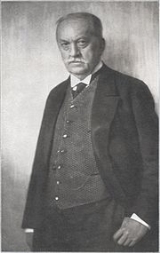
Friedrich Schultze
Encyclopedia
Friedrich Schultze was a German neurologist
who was a native of Rathenow
, Brandenburg
. He is known for being the founder of child neurology.
In 1871 he earned his doctorate at Heidelberg, and afterwards spent several years as an assistant to pathologist Nikolaus Friedreich
(1825–1882). In 1887 he was invited as a "full professor" to the University of Dorpat, and shortly afterwards became director of the medical clinic and policlinic at the University of Bonn
, where he spent the remainder of his career.
Schultze is remembered for his numerous medical publications regarding neuroanatomical
and neuropathological
investigations that he performed. In 1884 he was credited with being the first physician to describe a neurological disorder that later became known as Charcot-Marie-Tooth disease
. He also provided an early description of acroparesthesia
. In 1891 with Wilhelm Heinrich Erb
(1840–1921) and Adolph Strümpell
(1853–1925), he founded the journal Deutsche Zeitschrift für Nervenheilkunde.
His name is lent to the eponymous comma tract of Schultze (interfascicular fasciculus), which is a compact bundle of posterior root fibers situated near the border between the fasciculus gracilis
(tract of Goll) and cuneate fasciculus (tract of Burdach) of the spinal cord
.
Neurologist
A neurologist is a physician who specializes in neurology, and is trained to investigate, or diagnose and treat neurological disorders.Neurology is the medical specialty related to the human nervous system. The nervous system encompasses the brain, spinal cord, and peripheral nerves. A specialist...
who was a native of Rathenow
Rathenow
Rathenow is a town in the district of Havelland in Brandenburg, Germany, with a population of 26,433 .-Overview:The Protestant church of St. Marien Andreas, originally a basilica, and transformed to the Gothic style in 1517-1589, and the Roman Catholic Church of St...
, Brandenburg
Brandenburg
Brandenburg is one of the sixteen federal-states of Germany. It lies in the east of the country and is one of the new federal states that were re-created in 1990 upon the reunification of the former West Germany and East Germany. The capital is Potsdam...
. He is known for being the founder of child neurology.
In 1871 he earned his doctorate at Heidelberg, and afterwards spent several years as an assistant to pathologist Nikolaus Friedreich
Nikolaus Friedreich
Nikolaus Friedreich was a German pathologist and neurologist, and a third generation physician in the Friedreich family...
(1825–1882). In 1887 he was invited as a "full professor" to the University of Dorpat, and shortly afterwards became director of the medical clinic and policlinic at the University of Bonn
University of Bonn
The University of Bonn is a public research university located in Bonn, Germany. Founded in its present form in 1818, as the linear successor of earlier academic institutions, the University of Bonn is today one of the leading universities in Germany. The University of Bonn offers a large number...
, where he spent the remainder of his career.
Schultze is remembered for his numerous medical publications regarding neuroanatomical
Neuroanatomy
Neuroanatomy is the study of the anatomy and organization of the nervous system. In contrast to animals with radial symmetry, whose nervous system consists of a distributed network of cells, animals with bilateral symmetry have segregated, defined nervous systems, and thus we can begin to speak of...
and neuropathological
Neuropathology
Neuropathology is the study of disease of nervous system tissue, usually in the form of either small surgical biopsies or whole autopsy brains. Neuropathology is a subspecialty of anatomic pathology, neurology, and neurosurgery...
investigations that he performed. In 1884 he was credited with being the first physician to describe a neurological disorder that later became known as Charcot-Marie-Tooth disease
Charcot-Marie-Tooth disease
Charcot–Marie–Tooth disease- , known also as Morbus Charcot-Marie-Tooth, Charcot-Marie-Tooth neuropathy, hereditary motor and sensory neuropathy , hereditary sensorimotor neuropathy , or peroneal muscular atrophy, is an inherited disorder of nerves that takes different forms...
. He also provided an early description of acroparesthesia
Paresthesia
Paresthesia , spelled "paraesthesia" in British English, is a sensation of tingling, burning, pricking, or numbness of a person's skin with no apparent long-term physical effect. It is more generally known as the feeling of "pins and needles" or of a limb "falling asleep"...
. In 1891 with Wilhelm Heinrich Erb
Wilhelm Heinrich Erb
Wilhelm Heinrich Erb was a German neurologist who was a native of Winnweiler, Rhineland-Palatinate.- Academic career :...
(1840–1921) and Adolph Strümpell
Adolph Strümpell
Ernst Adolf Gustav Gottfried von Strümpell was a German neurologist who was born at Neu-Autz Estate, Courland Governorate...
(1853–1925), he founded the journal Deutsche Zeitschrift für Nervenheilkunde.
His name is lent to the eponymous comma tract of Schultze (interfascicular fasciculus), which is a compact bundle of posterior root fibers situated near the border between the fasciculus gracilis
Fasciculus gracilis
The fasciculus gracilis is a bundle of axon fibres in the posterior column of the spinal cord and carries information from the middle thoracic and lower limbs of the body...
(tract of Goll) and cuneate fasciculus (tract of Burdach) of the spinal cord
Spinal cord
The spinal cord is a long, thin, tubular bundle of nervous tissue and support cells that extends from the brain . The brain and spinal cord together make up the central nervous system...
.

